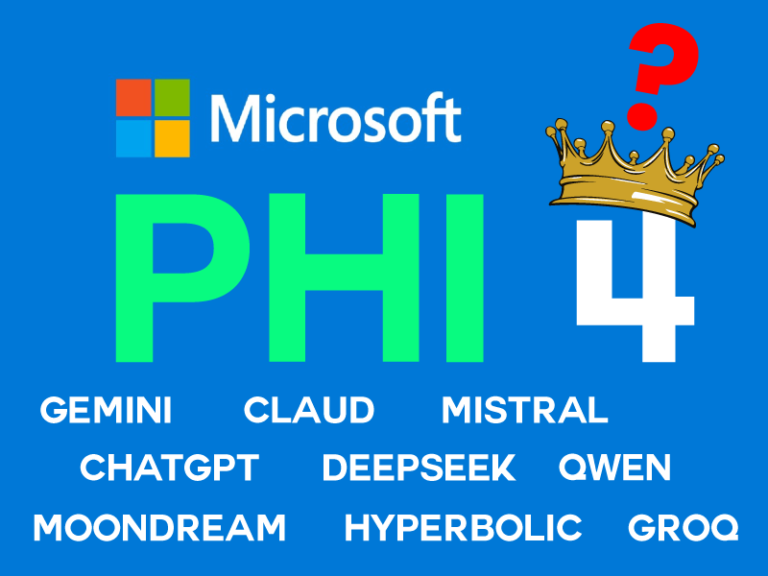If you are not tuned in all the time you might have missed this, just like me. A tiny yet mighty AI model that’s turning heads in Silicon Valley.
Microsoft’s Phi-4 isn’t just another tech breakthrough – it’s like having a brilliant friend who can tackle complex tasks while running on minimal power is what the early adopters are saying but some beg to differ.
When folks ask me about Phi-4, I tell them to imagine shrinking down the brainpower of larger AI models into something that fits in your pocket. It’s fascinating how Microsoft pulled this off – they’ve essentially created a small-but-mighty model that punches way above its weight class.
What makes Phi-4 special?
Well, if you’ve ever tried running advanced AI on your laptop, you know it can be like trying to fit an elephant into a maruti suzuki.
But some claim that Phi-4 changes that game entirely.
It’s remarkably efficient, turning what used to need a supercomputer into something that could work on your phone.
The real magic lies in its training approach.
Think of it like teaching a child – instead of overwhelming them with everything at once, Microsoft focused on quality over quantity.
They handpicked the most relevant knowledge, resulting in a model that’s not just smaller, but often smarter in practical ways.
But here’s the kicker – Phi-4 isn’t just about raw performance.
If larger language models are like encyclopedias, Phi-4 is more like that sharp friend who might not know everything but knows exactly what matters.
It excels at coding tasks, understands context brilliantly, and can even handle some math problems that would make bigger models sweat but for tasks like copywriting Claude is still the best and for reasoning o1 model still performce best.
No Supercomputer needed for Phi-4
For developers and tech enthusiasts, this means having an AI assistant that’s both powerful and practical – like having a coding buddy who doesn’t need a supercomputer to help you debug your latest project.
Let me break down how Microsoft’s Phi-4 works in a way that feels more personal and relatable,
You know how sometimes the simplest solutions are the most brilliant?
That’s exactly what Microsoft’s engineers figured out with Phi-4.
Instead of building another power-hungry AI giant, they took a different path – one that’s clever, efficient, and surprisingly straightforward.
Think of Phi-4 like a star student who learned from the best tutors.
Rather than cramming endless information, the team carefully picked what to teach it.
They focused on quality training data, kind of like choosing the right textbooks for a challenging course.
This selective approach helps Phi-4 understand context better than you might expect from its compact size.
What really gets me excited is how Phi-4 handles different tasks.
Whether you’re coding, analyzing data, or solving complex problems, it adapts like a skilled professional who knows exactly which tool to use for each job. It’s like having a Swiss Army knife that actually knows how to use all its attachments effectively.
Looking at real-world applications, Phi-4 shows its versatility. In healthcare, it helps doctors make sense of patient data without needing massive computing power.
For businesses, it’s like having a sharp analyst who can spot patterns and suggest improvements quickly.
And for developers? It’s that helpful colleague who can review your code and spot issues before they become problems.
The magic happens in how Phi-4 processes information.
Instead of brute-forcing solutions, it uses smart shortcuts and efficient pathways – kind of like knowing all the back roads to avoid traffic.
This clever approach means it can run on smaller devices while still delivering impressive results.
But perhaps what impresses me most is how it keeps learning and adapting.
Each interaction makes it a bit sharper, a bit more tuned to real-world needs. It’s like watching a talented apprentice gradually master their craft.
So, you’re ready to dive into Phi-4?
I’ve been there, and I’ll walk you through it just like I’d help a friend get started with a new tool.
First up, getting your hands on Phi-4 is pretty straightforward.
It’s like setting up any other Microsoft service – head to their website, create an account (or use your existing Microsoft one), and pick a plan that makes sense for what you need. Don’t worry too much about choosing the perfect plan right away; you can always adjust later as you figure out what works best for you.
Once you’re in, take some time to explore the dashboard.
You know how overwhelming a new interface can be, right? My advice? Start with the basics. Click around, see where everything is – it’s like getting to know the layout of a new apartment. The dashboard is your home base, and you can rearrange it to match how you work best.
If you’re already using other Microsoft tools like Office 365 or Azure, you’re in luck.
Phi-4 plays nice with these – it’s like adding a new friend to your existing group.
The integration is smooth, though you might need to tinker with the settings a bit to get everything just right.
The best part? You don’t need to be a tech wizard to get started. Sure, some basic knowledge of cloud computing or data analysis helps, but Phi-4 is built for real people. Think of it like a sophisticated car – you don’t need to know every detail under the hood to drive it effectively.
Speaking of real-world use, I think Phi-4 has the potential to make waves across different fields.
Healthcare providers can use it to make sense of patient data, retailers streamline their inventory, and teachers can create more engaging lessons.
Each industry can find its own sweet spot with the tool.
Try different models here.
Looking ahead, Microsoft keeps fine-tuning Phi-4 based on how people actually use it. It’s like watching a good tool become great through constant refinement and real user feedback.
Remember, everyone starts somewhere.
Take your time, experiment a bit, and don’t hesitate to check out the tutorials if you get stuck.
The community forums are pretty helpful too – full of people who’ve been exactly where you are now.



